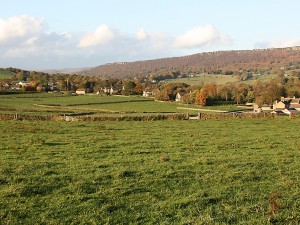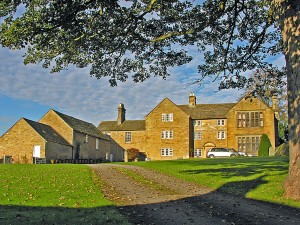|
1
|
2
-
Friendly Fitness @ BVH
Friendly Fitness @ BVH
02/04/2024 @ 09:30 - 10:30
Baslow Village Hall, Baslow, Bakewell DE45 1SR, UK
TUESDAYS 9.30AM
£8 per class
Instructor: Laurie Cooper
E:info@wellbeinginthepeaks.com
Friendly Fitness is the ultimate blend of fitness elements that will improve your health, fitness, and overall wellbeing. It's a unique and balanced approach to exercise, combining mobility & stability, strength and cardio training, rounding off with stretching and relaxation
Carefully structured to offer a well-rounded and balanced workout experience. Each session is led by Laurie Cooper, a dedicated fitness expert committed to guiding you through safe and effective exercises. Expect a combination of flowing movements, energetic bursts, and focused strength exercises.
Suitable for individuals of all fitness levels. Whether you're a beginner looking to establish a strong fitness foundation or an experienced enthusiast seeking a diverse and challenging workout.
Key benefits:
- Improved overall fitness and health
- Enhanced joint mobility and stability
- Increased cardiovascular endurance
- Improved strength
- Greater flexibility and reduced muscle tension
See more details
•
|
3
|
4
-
Children's Street Dance then Musical Theatre at BVH
Children's Street Dance then Musical Theatre at BVH
04/04/2024 @ 17:00 - 18:45
Baslow Village Hall, Baslow, Bakewell DE45 1SR, UK
See more details
•
|
5
-
Senior Citizens
Senior Citizens
05/04/2024 @ 14:00 - 16:00
Baslow Village Hall, Nether End, Baslow, Baslow, Nr Bakewell DE45 1SR, UK
See more details
•
|
6
|
7
|
|
8
|
9
-
Friendly Fitness @ BVH
Friendly Fitness @ BVH
09/04/2024 @ 09:30 - 10:30
Baslow Village Hall, Baslow, Bakewell DE45 1SR, UK
TUESDAYS 9.30AM
£8 per class
Instructor: Laurie Cooper
E:info@wellbeinginthepeaks.com
Friendly Fitness is the ultimate blend of fitness elements that will improve your health, fitness, and overall wellbeing. It's a unique and balanced approach to exercise, combining mobility & stability, strength and cardio training, rounding off with stretching and relaxation
Carefully structured to offer a well-rounded and balanced workout experience. Each session is led by Laurie Cooper, a dedicated fitness expert committed to guiding you through safe and effective exercises. Expect a combination of flowing movements, energetic bursts, and focused strength exercises.
Suitable for individuals of all fitness levels. Whether you're a beginner looking to establish a strong fitness foundation or an experienced enthusiast seeking a diverse and challenging workout.
Key benefits:
- Improved overall fitness and health
- Enhanced joint mobility and stability
- Increased cardiovascular endurance
- Improved strength
- Greater flexibility and reduced muscle tension
See more details
-
Baslow History Group
Baslow History Group
09/04/2024 @ 19:30 - 20:30
Baslow Village Hall, Nether End, Baslow, Baslow, Nr Bakewell DE45 1SR, UK
See more details
• •
|
10
-
Mobile Library at Church View Drive
-
Mobile Library at Baslow Village Hall
Mobile Library at Baslow Village Hall
10/04/2024 @ 12:15 - 12:40
See more details
• •
|
11
-
Children's Street Dance then Musical Theatre at BVH
Children's Street Dance then Musical Theatre at BVH
11/04/2024 @ 17:00 - 18:45
Baslow Village Hall, Baslow, Bakewell DE45 1SR, UK
See more details
•
|
12
|
13
|
14
|
|
15
|
16
-
Friendly Fitness @ BVH
Friendly Fitness @ BVH
16/04/2024 @ 09:30 - 10:30
Baslow Village Hall, Baslow, Bakewell DE45 1SR, UK
TUESDAYS 9.30AM
£8 per class
Instructor: Laurie Cooper
E:info@wellbeinginthepeaks.com
Friendly Fitness is the ultimate blend of fitness elements that will improve your health, fitness, and overall wellbeing. It's a unique and balanced approach to exercise, combining mobility & stability, strength and cardio training, rounding off with stretching and relaxation
Carefully structured to offer a well-rounded and balanced workout experience. Each session is led by Laurie Cooper, a dedicated fitness expert committed to guiding you through safe and effective exercises. Expect a combination of flowing movements, energetic bursts, and focused strength exercises.
Suitable for individuals of all fitness levels. Whether you're a beginner looking to establish a strong fitness foundation or an experienced enthusiast seeking a diverse and challenging workout.
Key benefits:
- Improved overall fitness and health
- Enhanced joint mobility and stability
- Increased cardiovascular endurance
- Improved strength
- Greater flexibility and reduced muscle tension
See more details
-
Comedy Night @ BVH
Comedy Night @ BVH
16/04/2024 @ 19:30 - 22:00
Baslow Village Hall, Baslow, Bakewell DE45 1SR, UK
See more details
• •
|
17
|
18
-
Children's Street Dance then Musical Theatre at BVH
Children's Street Dance then Musical Theatre at BVH
18/04/2024 @ 17:00 - 18:45
Baslow Village Hall, Baslow, Bakewell DE45 1SR, UK
See more details
•
|
19
-
Senior Citizens
Senior Citizens
19/04/2024 @ 14:00 - 16:00
Baslow Village Hall, Nether End, Baslow, Baslow, Nr Bakewell DE45 1SR, UK
See more details
-
A celebration of Simon and Garfunkel
A celebration of Simon and Garfunkel
19/04/2024 @ 19:30 - 22:00
Baslow Village Hall, Baslow, Bakewell DE45 1SR, UK
See more details
• •
|
20
|
21
|
|
22
|
23
-
Friendly Fitness @ BVH
Friendly Fitness @ BVH
23/04/2024 @ 09:30 - 10:30
Baslow Village Hall, Baslow, Bakewell DE45 1SR, UK
TUESDAYS 9.30AM
£8 per class
Instructor: Laurie Cooper
E:info@wellbeinginthepeaks.com
Friendly Fitness is the ultimate blend of fitness elements that will improve your health, fitness, and overall wellbeing. It's a unique and balanced approach to exercise, combining mobility & stability, strength and cardio training, rounding off with stretching and relaxation
Carefully structured to offer a well-rounded and balanced workout experience. Each session is led by Laurie Cooper, a dedicated fitness expert committed to guiding you through safe and effective exercises. Expect a combination of flowing movements, energetic bursts, and focused strength exercises.
Suitable for individuals of all fitness levels. Whether you're a beginner looking to establish a strong fitness foundation or an experienced enthusiast seeking a diverse and challenging workout.
Key benefits:
- Improved overall fitness and health
- Enhanced joint mobility and stability
- Increased cardiovascular endurance
- Improved strength
- Greater flexibility and reduced muscle tension
See more details
•
|
24
|
25
-
Children's Street Dance then Musical Theatre at BVH
Children's Street Dance then Musical Theatre at BVH
25/04/2024 @ 17:00 - 18:45
Baslow Village Hall, Baslow, Bakewell DE45 1SR, UK
See more details
•
|
26
-
Sold out - Community Gong Bath at BVH
Sold out - Community Gong Bath at BVH
26/04/2024 @ 18:30 - 21:00
Baslow Village Hall, Baslow, Bakewell DE45 1SR, UK
An immersion in sacred sound, a moment to deeply relax, to have your mind quietened and your spirit at peace.💫Please ensure you arrive with everything you need, you can check on the 'What to Bring' page from the Menu💫
Info and tickets
https://www.gongsbyjulia.co.uk/event-details/april-bakewell-baslow-village-hall-community-gong-bath at https://www.gongsbyjulia.co.uk/event-details/april-bakewell-baslow-village-hall-community-gong-bath
See more details
•
|
27
|
28
|
|
29
|
30
-
Friendly Fitness @ BVH
Friendly Fitness @ BVH
30/04/2024 @ 09:30 - 10:30
Baslow Village Hall, Baslow, Bakewell DE45 1SR, UK
TUESDAYS 9.30AM
£8 per class
Instructor: Laurie Cooper
E:info@wellbeinginthepeaks.com
Friendly Fitness is the ultimate blend of fitness elements that will improve your health, fitness, and overall wellbeing. It's a unique and balanced approach to exercise, combining mobility & stability, strength and cardio training, rounding off with stretching and relaxation
Carefully structured to offer a well-rounded and balanced workout experience. Each session is led by Laurie Cooper, a dedicated fitness expert committed to guiding you through safe and effective exercises. Expect a combination of flowing movements, energetic bursts, and focused strength exercises.
Suitable for individuals of all fitness levels. Whether you're a beginner looking to establish a strong fitness foundation or an experienced enthusiast seeking a diverse and challenging workout.
Key benefits:
- Improved overall fitness and health
- Enhanced joint mobility and stability
- Increased cardiovascular endurance
- Improved strength
- Greater flexibility and reduced muscle tension
See more details
-
Hope Valley Active Travel masterplan project introduction
Hope Valley Active Travel masterplan project introduction
30/04/2024 @ 12:00 - 13:00
Microsoft Teams Meeting
Hello Sarah,
As per emails.
Regards
Michael
________________________________________________________________________________
Microsoft Teams Need help?
Join the meeting now
Meeting ID: 347 531 181 088
Passcode: 9oPJwD
________________________________
For organizers: Meeting options | Reset dial-in PIN
[https://apps.derbyshire.gov.uk/external-assets/skype/skype-dcc-logo-104x30.jpg]
________________________________________________________________________________
________________________________
The cold weather can cause problems for older and more vulnerable people. Get advice and support on how to Stay Well This Winter. Find out more on our website here.
________________________________
Think before you print! Save energy and paper. Do you really need to print this email?
Derbyshire County Council works to improve the lives of local people by delivering high quality services. You can find out more about us by visiting www.derbyshire.gov.uk.
If you want to work for us go to our job pages on www.derbyshire.gov.uk/jobs. You can register for e-mail alerts, download job packs and apply on-line.
________________________________
Please Note
This email is confidential, may be legally privileged and may contain personal views that are not the views of Derbyshire County Council. It is intended solely for the addressee. If this email was sent to you in error please notify us by replying to the email. Once you have done this please delete the email and do not disclose, copy, distribute, or rely on it.
Under the Data Protection Act 2018 and the Freedom of Information Act 2000 the contents of this email may be disclosed.
Any personal information you have given us will be processed in accordance with our privacy notices, available at www.derbyshire.gov.uk/privacynotices.
Derbyshire County Council reserves the right to monitor both sent and received emails.
________________________________
See more details
• •
|
|
|
|
|
|


